 |
| The Independent Traveler's Newsletter PAGE FOUR |
 |
| The Independent Traveler's Newsletter PAGE FOUR |
|
FEATURING LORRAINE & ALSACE
 There is no doubt that when someone outside of France, or perhaps even someone living in France, hears the words which commonly group two regions together ~ Alsace-Lorraine ~ the first thought that comes to mind is of a place that was like a ping-pong ball, bouncing back and forth between Germany and France for as far back as one can remember. Somehow, though, once you have actually been there, your experience will give you a wider perspective. Lorraine, west of the Vosges mountains is a bucolic, green land of rolling landscapes, interesting cities and villages, and very French. Alsace, east of the Vosges mountains and bordered on the east by Germany's Black Forest and the Rhine, is fertile and dotted with vineyards producing white wine. They have their remnants of war, to be sure, the most famous being in Lorraine's Meuse département ~ the battlefields and cemeteries of Verdun. In all, six départements fill this region, each with its own characteristics. 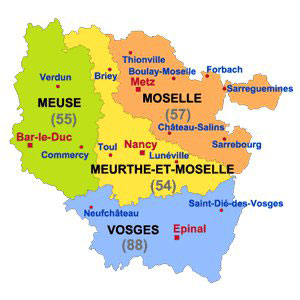 Lorraine, the larger of the two regions by far, is made up of four départements: the southernmost Vosges (88); Moselle (57) named for the river flowing southward into it and bounded by Luxembourg on the north and Germany on the north and east; Meurthe-et-Moselle (54) and the Meuse (55) that share their northern border with Belgium. Lorraine is considered 'undiscovered' by many, thus making it an even better choice for a holiday. With its rivers and beautiful countryside, Lorraine is the ideal place for a relaxing vacation. Historically, Lorraine was disputed between Frankish and German kings as far back as the ninth century. These regions were part of Charlemagne's Frankish empire at that time. The Duchy of Lower Lorraine even went to the Netherlands in the tenth century. Fought over between dukedoms for hundreds of years, Louis XIII received most of Lorraine for France (except Nancy) from Duke Charles IV in 1632 during the Thirty Years' War. Charles received his lands back in 1659 after the Treaty of the Pyrénées, but that was not the end of it. Hapsburgs entered the picture in the 18th century and more swapping took place. Finally, with the Treaty of Frankfurt in 1871, ending the Franco-Prussian War, Moselle, the city of Metz, and German Lorraine were among the lands ceded to the German Empire. France regained the territory in 1919 after World War I. There was conflict about France governing them, and there were attempts to suppress the German language and have state-run schools replace the church schools. A strong home rule governed Alsace and Lorraine until the 1920s. Early in World War II, Germany annexed Alsace-Lorraine once again, and, finally, in 1945 at the end of the war the territory was returned to France. It is no longer an autonomous region but completely assimilated into France. The languages taught in schools are both French and German, but there is a German dialect known as Alsatian remaining in the region. The two largest cities in Lorraine are Nancy and Metz, each possessing many attributes to make a visit more than worthwhile. Metz, in the Moselle, was a Gallo-Roman stronghold and today is the capital of Lorraine. Situated at the confluence of the Moselle and Seille rivers, some twenty bridges cross the rivers and canals of the city. Upon a hill above the Moselle is the Cathédrale St-Etienne. It has a Gothic exterior with flying buttresses and gargoyles, but its lofty interior with stained glass windows in many architectural styles makes it glow. Some windows are by Marc Chagall. Metz also boasts the oldest theatre in France still in use, the Théatre de la Comédie on an island called Petit Saulcy. The gate near the cathedral, the 13th century Porte des Allemands, appears fortress-like with its medieval towers and imposing size spanning the river. The Musée d'Art et d'Histoire, known as La Cour d'Or, is situated in a deconsecrated monastery at 2, rue du Haut-Poirier and is open daily and closed on public holidays. It is fascinating for its Gallo-Roman thermal baths, Merovingian stone carvings, Gothic painted ceilings and a collection of paintings by French, Flemish and German artists. Visit the old part of the city, La Vieille Ville, and stroll past its 14th century homes. Most guide books suggest that you walk along the riverbanks in Metz for an enjoyable view of the city. Beyond Metz, but still in the Moselle, is the Parc Régional de Lorraine and a landscape dotted with many small forests. Nancy, in the département of Meurthe-et-Moselle, is a monument to the work of Stanislaus Leczynski, of whom we wrote in our Winter 1999 newsletter in our feature on the town of Lunéville. It was Stanislaus I of Poland who became a Duke of Lorraine ~ his daughter, Maria, having married Louis XV. As Duke Leopold, one of the Dukes of Lorraine, did much for Lunéville because his wife preferred living there to living in Nancy, so did Stanislaus do much for Nancy. It is said he embellished it beyond recognition and made it a model of the golden age of 18th century city planning. Nancy's second golden age began with glass maker Emile Gallé, the found of l'École de Nancy, the forerunner of the Art Nouveau movement in France. Visit the Musée des Beaux Arts at 3, place Stanislas to see wonderful work by Delacroix, Poussin and other artists such as Monet, Manet, Dufy and Modigliani. And, don't miss works by Georges de la Tour (1593-1652), the official painter of Lunéville and born nearby, at the Musée Historique Lorraine and, of course, Musée de l'École de Nancy. We were especially impressed with what we found in the Meuse département of Lorraine. We highly recommend visits to Verdun and the Cimitière National and Ossuaire located north of the city in the Forêt de Verdun. [The photo below shows the Ossuaire and cemetery at the top and the Mémorial de Verdun below.] It is here that the horrors of war really strike home ~ trenches still branch off the roads in some places, vivid reminders of how the armies lived, fought and died in World War I. Cemeteries are filled with soldiers of many nationalities. Despite evidence of war, the Meuse is also a tranquil and beautiful part of Lorraine of which we are very fond. We recommend accommodations at the elegant Château des Monthairons, where you will find luxury lodging for a wide range of prices, a magnificent restaurant and a peaceful location on the banks of the River Meuse. 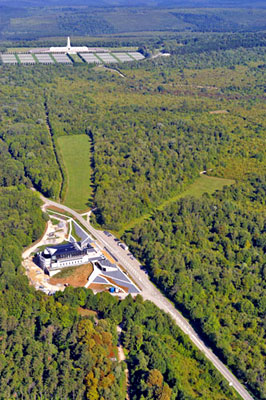 Before we leave Lorraine and move eastward to Alsace, we want to pay a brief visit to the Vosges département. This large portion of Lorraine stretches from the Vosges Mountains and Alsace on the east to the regions of Champagne-Ardenne on the west and Franche-Comte on the south. Not exactly the most visited part of France, few towns may sound familiar with the exception of Vittel, known for its bottled water and famous springs at the foot of the Vosges Mountains. The bottling plant is open for public tours. The southern Vosges is spa country ~ you will find old-style spa architecture and a resort atmosphere surrounded by beautiful parks and gardens. The largest city in the Vosges is Epinal, while one of the most pleasant is Gérardmer, situated on a beautiful lake. Long a center for woodcarving, it is rapidly becoming a vacation spot in the summer months with water sports on the lake and a winter ski resort when snow covers the steep slopes of the Vosges Cristallines. The département provides a most scenic landscape for country drives and mountain hiking. Quite interesting and beautiful is the Route des Crêtes. A strategic road about 50 miles long, it clings to the western edge of the Vosges and was created in World War I to protect French troops from discovery. It proceeds through woodlands for the most part and is the place to be for breathtaking views of Lorraine from its high points. The Mémorial museum then and now 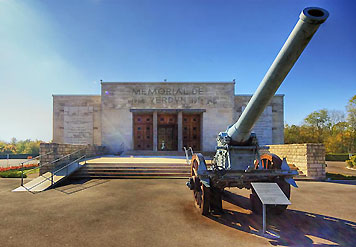 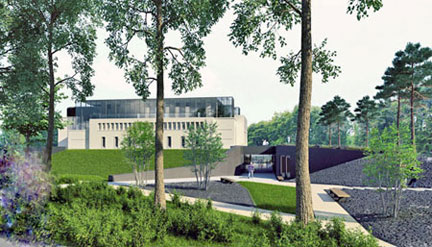 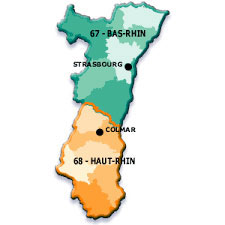 Alsace is
unique in all of France, with
its cuisine, architecture and dialect influenced so strongly by and
having been part of Germany for some 700 years. Prior to that
period, during Roman times, Alsace was part of Gaul, and between 1639
and 1681 it was retaken by France a little at a time where it remained
until 1871 when it was returned to Germany in the Treaty of
Frankfurt. In 1918, France retook possession of Alsace, lost it
briefly again from 1940-1945, and it has been a part of France ever
since. Made up of the départements of Bas-Rhin (67) and Haut-Rhin (68), today the people of
Alsace are fiercely French despite their long history of German
influence. Alsace is
unique in all of France, with
its cuisine, architecture and dialect influenced so strongly by and
having been part of Germany for some 700 years. Prior to that
period, during Roman times, Alsace was part of Gaul, and between 1639
and 1681 it was retaken by France a little at a time where it remained
until 1871 when it was returned to Germany in the Treaty of
Frankfurt. In 1918, France retook possession of Alsace, lost it
briefly again from 1940-1945, and it has been a part of France ever
since. Made up of the départements of Bas-Rhin (67) and Haut-Rhin (68), today the people of
Alsace are fiercely French despite their long history of German
influence.Famous for its dry, crisp white wines, Alsace is brimming over with flower-filled, picturesque villages and medieval towns. Its position east of the Vosges Mountains in the Rhine River valley makes it especially appealing to tourists. Boating on the Rhine is a popular way to see Alsace, and the region is as pleasant and popular in the warmer months as it is in the winter when snow covers the mountains. The vineyards of Alsace draw visitors from all over the world, so one must take special notice of the Route du Vin, a 112-mile course between Marlenheim in the north to Thann in the south. Not only will a leisurely trip along the route allow for frequent wine tastings, but it will permit stops in some of the most charming villages in eastern France. There is Kayserberg (the birthplace of Albert Schweitzer), Sigolsheim (see the war memorial), and Riquewihr, bustling and beautiful ~ the entire town is an historic landmark and one of the Most Beautiful Villages of France (see our page one photo). Riquewihr, a most popular village on the wine route, is worth a visit to see its 16th and 17th century houses, the 13th century gate (the Dolder), and a profusion of fountains and flowers. Riquewihr is said to produce one of the world's best Reisling wines. Colmar, farther south along the route is famous for its Petite Venise, its canal quarter. [See page 5 for the Christmas Markets of Colmar.] Shipping wine from this port city of 65,000 began in the 16th century. And, don't miss Haut-Koenigsbourg Castle, just north of Riquewihr, rebuilt for Kaiser Wilhelm II at the beginning of the 20th century. In 1918, upset by the course of World War I, he left an inscription at the castle reading, "I did not want this." Strasbourg is such a delightful city ~ one of our favorites in all of France. It is the seat of the Council of Europe (in the modern Palais de l'Europe), the European Commission, the Court of Human Rights and the European Parliament. It has wonderful museums, magnificent churches, an excellent opera, Alsatian cuisine and winestubs (wine bars), and it is a friendly and beautiful city. Strasbourg is also known for its scientific community with over 250 laboratories and more than 4,000 researchers in and around the city. Strasbourg's wide range of architectural styles successfully blend together, from the sweeping glass buildings of the Parliament to the wood and brick buildings in the 2000-year old quarter known as la Petite-France [photo below]. Be sure to take the cruise on the River L'Ill (as calm as a canal) of under two hours that will show you both and much more with commentary in French, English and German. The canal cruise and leisurely walks are the best ways to see the city. Once again, the Romans settled in a part of what today is France. In 12 BC, a Roman military camp was built near the Rhine on land surrounded by the River Ill, and it was named Argentoratum. The Barbarians invaded and destroyed the town, but it was rebuilt and renamed Strateburgum which meant 'town of roads', as it was really at the crossroads of Europe. Growing and booming in the Middle Ages, Strasbourg drew intellectuals, tradesmen and craftsmen from all over the region. In 1176 the magnificent Cathédrale de Notre Dame was begun when its foundation was laid. In 1277, the east façade was begun, and the cathedral was finally completed in 1439 when the incredible Gothic façade was crowned with a lacy spire reaching 465 feet into the sky. Inside, you will find the early Romanesque choir and a Gothic nave. The spectacular rose window, the Gothic Pillar des Anges (1230), and an Astronomical Clock are but a few more reasons to be sure to visit the cathedral. 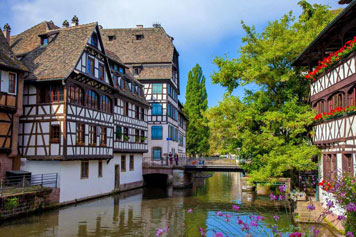 Restaurants
with excellent fare are not scarce in Strasbourg. In place de la Cathédrale you
can enjoy dinner in a 16th century house in the shadow of the
cathedral, Maison
Kammerzell. We had a memorable dinner at the
brasserie/restaurant L'Ancienne Douane (the old customs house), dining
under the stars on the balcony overlooking the river. Just inside
from where we were seated a group of folk dancers performed briefly,
which was very enjoyable. We were able to park our car for three
days in an underground garage at a very reasonable cost thanks to
advice from the bell captain at Hôtel des Rohan on rue du Marquin ~ the pedestrian
way in front of the cathedral. From our fourth story window we
looked down on the promenade to see both Maison Kammerzell and the
cathedral lit up at night, and in the daytime we had the convenience of
turning left to stroll the little streets of la Petite France or turning right
to walk a few short blocks to the River L'Ill where we boarded the boat
for the cruise. The hotel is perfectly
located, the rooms are spacious and clean, and the staff is very
helpful and attentive. Breakfasts in the little dining room are
nice, and they are willing to go beyond the Continental fare and
prepare eggs if requested. Laundry service is available and
prompt. Restaurants
with excellent fare are not scarce in Strasbourg. In place de la Cathédrale you
can enjoy dinner in a 16th century house in the shadow of the
cathedral, Maison
Kammerzell. We had a memorable dinner at the
brasserie/restaurant L'Ancienne Douane (the old customs house), dining
under the stars on the balcony overlooking the river. Just inside
from where we were seated a group of folk dancers performed briefly,
which was very enjoyable. We were able to park our car for three
days in an underground garage at a very reasonable cost thanks to
advice from the bell captain at Hôtel des Rohan on rue du Marquin ~ the pedestrian
way in front of the cathedral. From our fourth story window we
looked down on the promenade to see both Maison Kammerzell and the
cathedral lit up at night, and in the daytime we had the convenience of
turning left to stroll the little streets of la Petite France or turning right
to walk a few short blocks to the River L'Ill where we boarded the boat
for the cruise. The hotel is perfectly
located, the rooms are spacious and clean, and the staff is very
helpful and attentive. Breakfasts in the little dining room are
nice, and they are willing to go beyond the Continental fare and
prepare eggs if requested. Laundry service is available and
prompt.Museums in Strasbourg are numerous, including Musée d'Art Moderne et Contemporain, the Musée Alsacien, the Palais Rohan which incorporates the Musée des Beaux Arts, Musée Archéologique and the Musée des Arts Décoratifs, and one we especially enjoyed, the Galerie de l'Ancienne Douane the large building that houses the restaurant of the same name that we mentioned above. It's history as the customs house began in 1358, and its purpose was to control and store goods moving along the river to the Rhine. Primarily, the goods being shipped were tobacco, wine and fish. In 1497 it was destroyed in a fire and rebuilt ten years later. The building became known as 'the old customs house' when Customs departed in 1803. It became a wine market for a time, a leaf tobacco store and the city's fish market at the end of the 19th century. The Old Customs was destroyed by Allied bombing in 1944 and rebuilt once again in 1962 and 1965 in a more refined style. The L'Ancienne Douane restaurant was destroyed by fire in early June of 2000 and reopened in 2001 after a year of restoration work. Any season is perfect for a trip to Strasbourg and elsewhere in Alsace or Lorraine. We encourage everyone to visit soon ~ and more than once! . . . continued on page five SPONSORING THIS ISSUE Find
France's
most special places to stay on a web site that offers au
Château offers
over 80 unique properties for bed and breakfast accommodations,
Visit au
Château today! |
|
 previous
page
next page previous
page
next page |